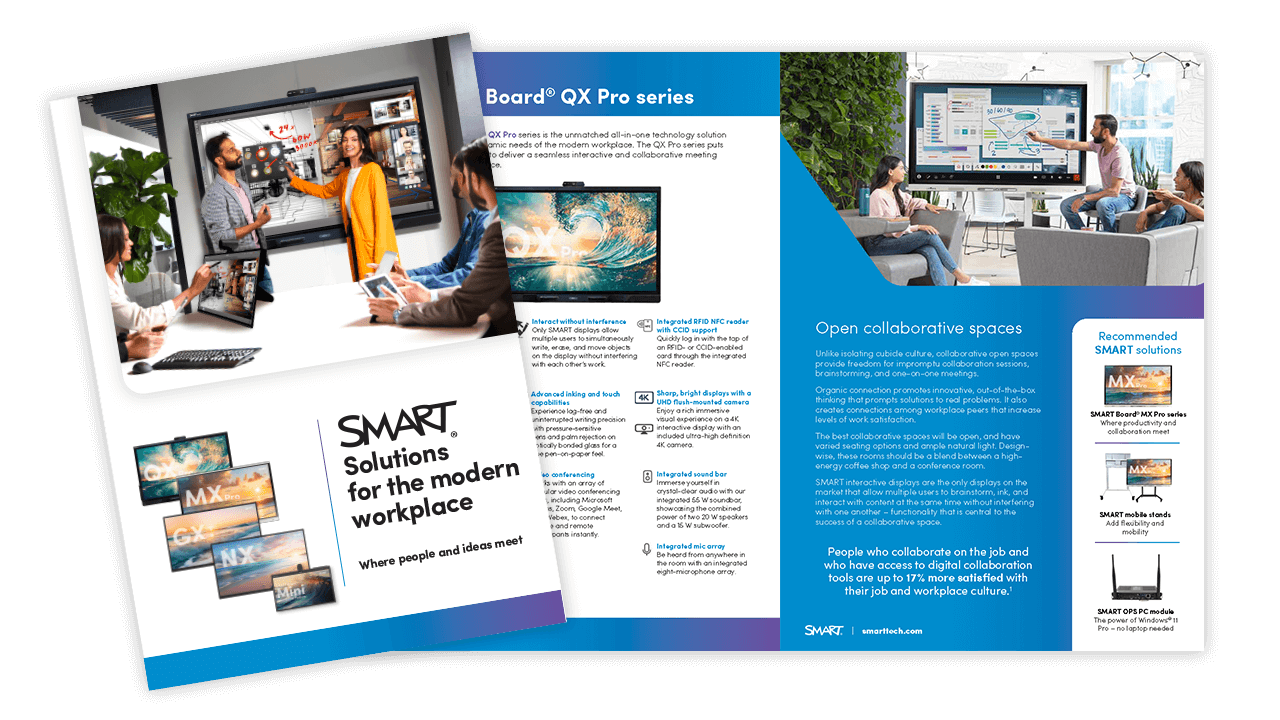51% of Gen Z students have said that they learn best ‘by doing’.
As these digital natives fill the halls of universities and colleges, it’s important that institutions provide the tools and tech that will engage these students and support their learning preferences. Born into a digital-first world, Gen Z students need educational technology that engages and empowers them, while helping connect them with the content they’re learning, and what they can do with it beyond the classroom.
If your higher education institution is looking for ways to attract both students and faculty, one important piece of technology for lecture halls, seminar rooms, study spaces and meeting areas are interactive displays. These large-scale touchscreen devices operate just like an iPad or Microsoft Surface, and are becoming increasingly prevalent in higher learning spaces as they bridge the gap between traditional teaching methods and dynamic Gen Z learning styles.
But aside from being able to show innovative technology, are there any actual benefits to having interactive displays on your campus? In short: yes.
Enable educators to deliver engaging lectures
Interactive displays transform traditional lectures into dynamic, immersive experiences that capture and sustain student attention.
Unlike static whiteboards or projector screens, these displays allow educators to incorporate multimedia elements, live annotations, and real-time feedback into their lessons. Visual aids such as videos, diagrams, and interactive simulations can be integrated into the lecture or lesson, making complex concepts easier to understand. This level of interactivity caters to the Gen Z learning style, who thrive in environments where they can actively engage with digital content rather than passively consume information.
Moreover, interactive learning tools empower educators to adapt their teaching methods to suit a variety of subjects and classroom scenarios. For example, users can use split-screen functionality to display multiple resources simultaneously: one half could be an anatomical diagram and on the other a page from The China Study to supplement it. Many interactive displays also have in-built graphical organizers and templates so that it’s quick and simple to use something such as a timeline or process diagram, ready-made.
Student collaboration
Group projects, brainstorming sessions, and study-dates have always been a core part of the university experience for students – and Gen Z are no different.
The best interactive displays help groups work together by enabling multiple users to write, erase, and interact at the same time without interfering with one another – giving each a voice and sense of ownership in their learning. So, whether history students are analyzing a source together, or physicists are working through a math problem, they can do so in a fluid and uninterrupted, truly collaborative manner. Instead of having to use multiple physical sheets of paper where mistakes are messily scrawled out and work is confined to the size of the page, digital whiteboarding means that work stays tidy, and students can keep expanding the canvas for near-infinite team collaboration.
In addition, interactive displays seamlessly integrate with remote collaboration tools, allowing students to work together regardless of their location. For hybrid and online learning setups, students can use the display to connect to popular platforms such as Zoom or Microsoft Teams, share screens, and contribute to shared documents or presentations in real-time. This capability ensures that all students, whether in-person or remote, have an equal opportunity to participate actively in group work.
Preparation for future careers
In almost every professional environment, teamwork, problem-solving, and digital fluency are critical competencies. While Gen Z may be digital natives, it is still crucial that higher education institutions set them up for success with the human side of technology mastered, too.
Graduates should leave university confident in their ability to walk into a meeting room and deliver a dynamic presentation to stakeholders, peers, and colleagues. As more and more organizations adopt interactive solutions into their hybrid workspaces, technology that drives connectivity between colleagues is critical for everyone to navigate. The ability to adapt to evolving technology is a significant advantage for students entering the workforce, and interactive displays provide a versatile medium for introducing these tools in an accessible and engaging way.
Furthermore, interactive displays allow educators to integrate career-focused applications and tools directly into their teaching. For instance, students can engage with industry-standard software, practice simulations in fields like engineering or healthcare. By bridging the gap between academic theory and practical application, interactive displays ensure that Gen Z students graduate with the technical proficiency and collaborative mindset needed to thrive in their future careers.
The future, in your hands
Interactive displays are the way forward for attracting new students, helping current students excel, and ensuring graduates are prepared for their career.
SMART helps higher education institutions and their students be future-ready. With the most natural interactive writing experience on the market, SMART enables users to pick up a pen, write, and save annotations in common file formats without clunky overlays or awkward annotations.
We have robust and reliable interactive displays available for any institution on any budget:
- QX Pro series: The all-in-one performance display with the in-built video conferencing equipment your institution needs for remote and hybrid learning.
- MX Pro series: The perfect balance between budget and feature rich functionality. Good for institutions who have their own video conferencing equipment.
- GX series: Our introduction to interactivity with just the essentials needed for team collaboration. Great for smaller classrooms and in-person brainstorming sessions.
In a rapidly evolving educational landscape, meeting the expectations of Gen Z students is no longer optional - it’s essential for higher education institutions seeking to remain competitive and relevant. The question isn’t whether your higher learning institution can afford to adopt interactive displays. It’s whether you can afford not to.
Meet the needs of Gen Z learning styles with SMART today:

